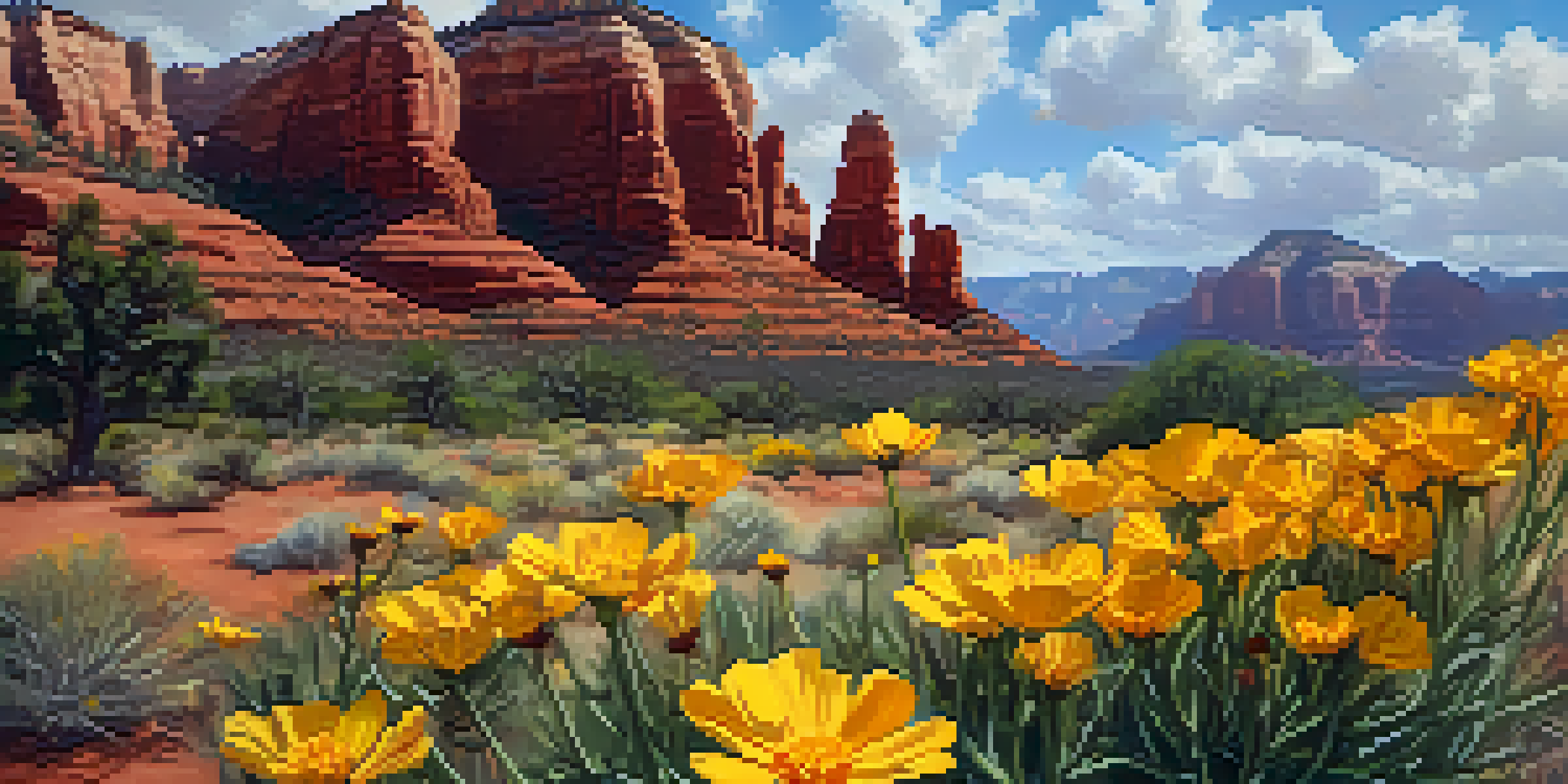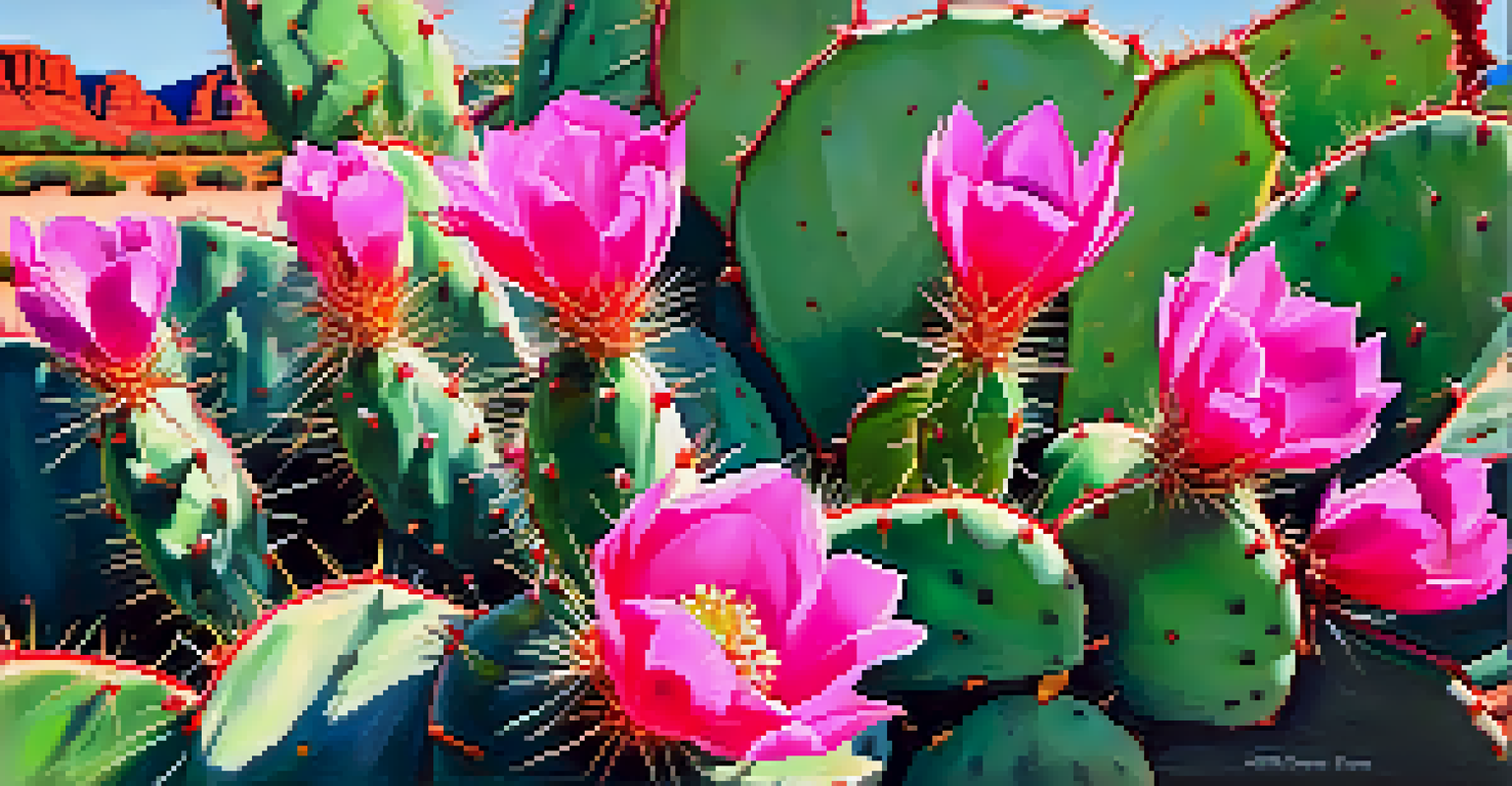Sedona's Native Flora: An Eco-Tourism Perspective

The Importance of Native Flora in Sedona's Ecosystem
Sedona's native flora plays a crucial role in maintaining the health of its ecosystem. These plants provide food and habitat for a diverse array of wildlife, creating a balanced environment. By understanding the interconnectivity of plants and animals, we can appreciate how each species contributes to the larger ecological picture.
In every walk with nature one receives far more than he seeks.
Moreover, native plants are adapted to the local climate and soil conditions, making them more resilient to environmental changes. This resilience ensures that the ecosystem remains stable, even in the face of challenges like climate change. For instance, the iconic juniper trees thrive in Sedona's arid climate, showcasing the beauty of nature's adaptability.
By protecting native flora, we not only preserve local biodiversity but also enhance the overall health of the landscape. This is particularly important for eco-tourism, as visitors come to Sedona to experience its natural beauty. Promoting awareness about these plants can foster a deeper connection between tourists and the environment.
Highlighting Sedona's Unique Plant Species
Sedona is home to a variety of unique plant species that contribute to its stunning landscape. Take, for example, the vibrant desert marigold, which bursts into color with its bright yellow flowers. These plants not only add beauty to the scenery but also play vital roles in local ecosystems.

Another fascinating plant is the prickly pear cactus, known for its edible pads and fruit. This cactus is not only a culinary delight but also provides sustenance for local wildlife. Observing these plants in their natural habitat can offer visitors a glimpse into the intricate relationships within Sedona's ecosystem.
Native Flora Supports Local Ecosystem
Sedona's native plants are vital for maintaining biodiversity and providing food and habitat for wildlife.
In addition to their ecological importance, these unique species serve as a draw for eco-tourists. By learning about and appreciating these plants, visitors can deepen their understanding of Sedona's natural heritage. Eco-tourism initiatives can highlight these species, promoting conservation while enhancing the visitor experience.
Eco-Tourism: A Path to Conservation
Eco-tourism is a growing industry that emphasizes sustainable travel and conservation efforts. In Sedona, this movement encourages visitors to explore the area while respecting its natural resources. By promoting responsible tourism practices, we can help preserve the stunning landscapes and native flora that draw people to this region.
The clearest way into the Universe is through a forest wilderness.
Guided tours focused on native plants can provide educational experiences for tourists, fostering a sense of stewardship over the environment. These tours often highlight the importance of conservation and the need to protect fragile ecosystems. When tourists understand the significance of the native flora, they are more likely to support sustainable practices.
Additionally, eco-tourism can provide economic benefits to local communities. By attracting visitors who value nature and conservation, Sedona can support local businesses while ensuring the preservation of its natural beauty. This creates a win-win situation for both the environment and the economy.
The Role of Education in Eco-Tourism
Education is a cornerstone of effective eco-tourism, especially when it comes to understanding native flora. Knowledgeable guides can share insights about the plants' ecological roles, cultural significance, and uses. This educational aspect enhances the visitor experience and fosters a deeper appreciation for the environment.
Workshops and programs focused on native plant identification and conservation can engage visitors in hands-on learning. These experiences can range from guided hikes to interactive talks, allowing tourists to connect with the landscape in meaningful ways. Such initiatives empower visitors to take an active role in conservation efforts.
Eco-Tourism Promotes Conservation
Eco-tourism in Sedona encourages sustainable travel practices that help protect natural resources and enhance visitor experiences.
Moreover, education about native flora can extend beyond the immediate experience. Tourists who learn about the importance of these plants are likely to share their knowledge with others, spreading awareness and inspiring further conservation efforts. This ripple effect can lead to a broader movement of environmental stewardship.
Challenges Facing Sedona's Native Flora
Despite the beauty of Sedona's native flora, it faces numerous challenges. Climate change, invasive species, and urban development threaten the delicate balance of the ecosystem. As temperatures rise and precipitation patterns shift, native plants may struggle to survive, leading to declines in biodiversity.
Invasive species, often introduced by human activities, can outcompete native plants for resources. This competition can disrupt local ecosystems, causing a decline in native flora and the wildlife that depends on it. Awareness of these threats is essential for effective conservation efforts.
Urban development poses another significant challenge, as expanding communities often encroach on natural habitats. Balancing growth with ecological preservation is critical for the future of Sedona's native plants. By prioritizing sustainable development, we can help protect these valuable resources for generations to come.
Community Involvement in Conservation Efforts
Community involvement is vital for the success of conservation efforts in Sedona. Local organizations often host events and initiatives aimed at protecting native flora and educating residents and visitors alike. These grassroots movements can create a strong sense of community and shared responsibility for the environment.
Volunteering for habitat restoration projects is a great way for locals and visitors to contribute directly to conservation efforts. Whether it's planting native species or removing invasive plants, hands-on activities foster a connection to the land. Such involvement can also inspire individuals to advocate for sustainable practices in their own lives.
Community Engagement Drives Success
Local involvement in conservation efforts fosters a sense of responsibility and strengthens eco-tourism initiatives in Sedona.
Additionally, community engagement can drive eco-tourism initiatives that prioritize conservation. By showcasing local efforts and successes, Sedona can attract visitors who are passionate about preserving the environment. This collaborative approach not only protects native flora but also enhances the overall eco-tourism experience.
Future Directions for Eco-Tourism in Sedona
As Sedona's eco-tourism continues to grow, there are exciting opportunities for the future. Emphasizing sustainability and conservation will be key to attracting responsible travelers. Developing new eco-tourism experiences that focus on native flora can further enhance the region's appeal.
Innovative approaches such as eco-friendly accommodations and sustainable transportation can also be integrated into the tourism model. By offering visitors eco-conscious options, Sedona can position itself as a leader in sustainable tourism. This commitment not only benefits the environment but also enhances the overall visitor experience.

Looking ahead, collaboration among stakeholders, including local businesses, conservation groups, and government agencies, will be essential. By working together, Sedona can create a thriving eco-tourism industry that prioritizes native flora and environmental preservation. This collective effort will ensure that future generations can enjoy the natural beauty of Sedona.